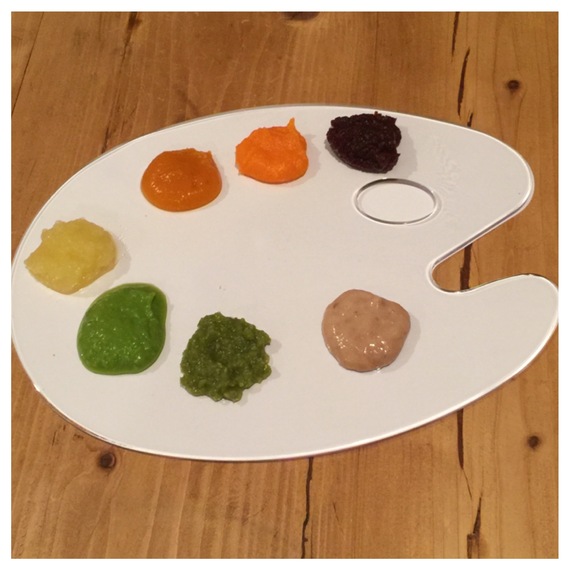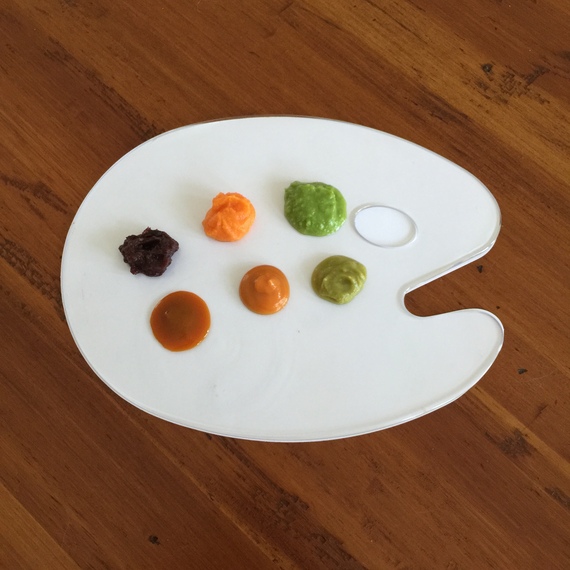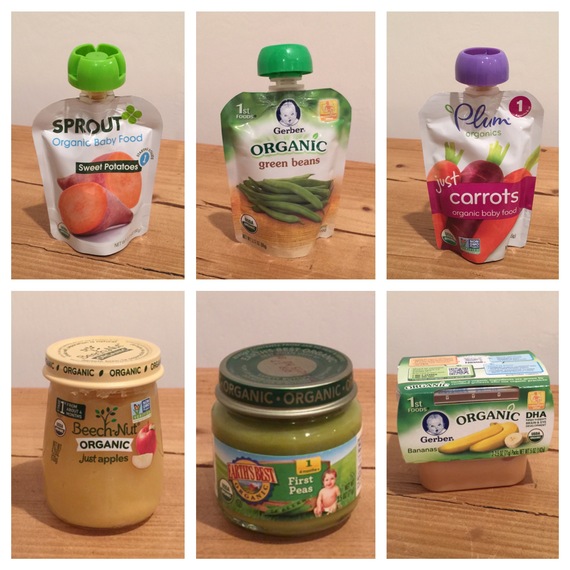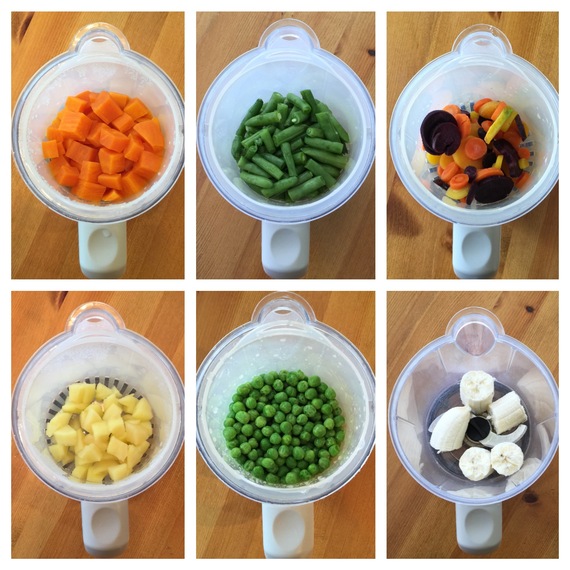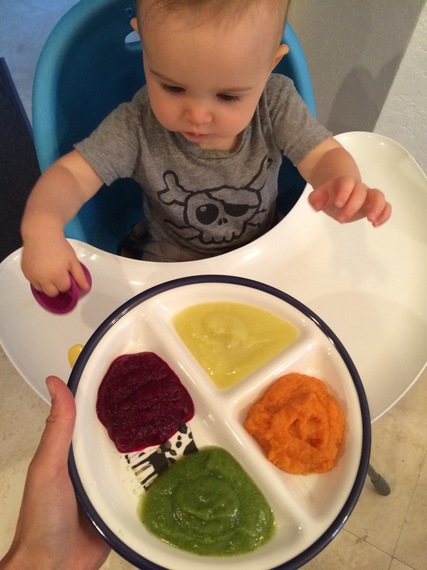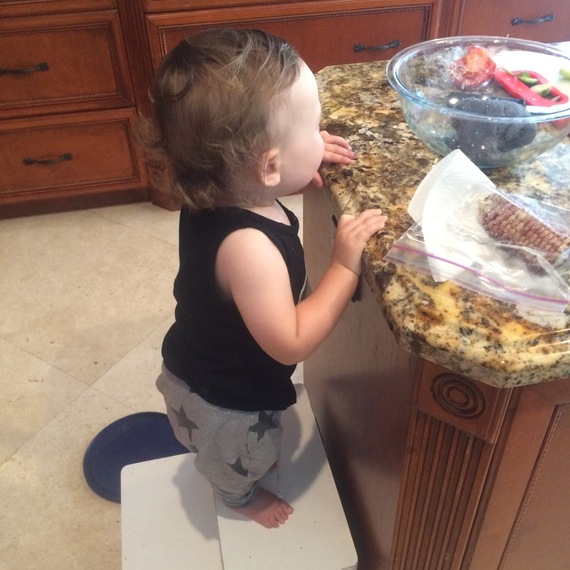(Counterclockwise from top right to bottom right: My palette of fresh organic homemade tricolor carrots, sweet potato, butternut squash, Fuji applesauce, sweet peas, green beans and banana purees.)
The other day a new parent told me, "I don't make my own baby food, but I only buy organic." She was confident and assured that her baby was getting "fresh organic fruits, vegetables, and whole grains" because of the "organic," "100 percent natural," made with "pure vegetables and fruits," "no artificial flavors," labels on the jar or squeeze pouch. She had no idea that she had begun her baby's relationship with a food imposter. How many times have you seen a "no artificial ingredients" label on a bunch of carrots? I will safely guess none because it is reserved for commercially-processed foods.
If you want a baby, toddler, child, tween, or teenager to love real fruits and vegetables, you must palatetrain them with the real deal. Palatetraining requires that your baby's first foods are fresh vegetable purees so your baby's anatomic "palate" and visual preferences are conditioned to have a life-long love of nutritious fresh foods. Fresh vegetables are bright, colorful, and diverse in taste and texture -- qualities that stimulate the senses and develop baby's food preferences. Through repeated exposure you are influencing your baby's delicate neurophysiology.
I understand that in today's fast-paced world, it is difficult to find the time to make your own baby food, but be informed (buyer beware) of the major shortcomings of giving your child, especially from four months to one year, jarred or packaged baby food -- organic or not. I'm a full-time working mother of two children under 5 years old and I am NOT here to convince you not buy those fabulously-convenient commercial squeeze pouches and jarred baby food, but I am here to tell you that they are for convenience and emergencies. They are NOT EQUIVALENT REPLACEMENTS for daily meals of fresh fruits, vegetables, whole grains and lean proteins, and this is why:
1) THEY DO NOT TASTE THE SAME
Have you ever tasted jarred or squeeze pouch vegetables vs. the real deal? Shelf-stable baby food is made in huge batches and is not fresh. For quality-control purposes, every batch is made to be similar in taste, color, smell and texture. In contrast, fresh vegetables have intense taste, color, smell, and texture variation; I call these the "dimensions of food." If you make your own pea puree, the variety of the legume, amount of added water, and extent to which it is pureed will vary each time. This batch diversity prepares baby for the natural variation that occurs in real food.
If baby's first food is processed, e.g., muted peas, the brain and senses become acclimated to very mild flavors, and then when you try to feed the baby fresh whole peas at 10-12 months, the taste, color, and texture are too overwhelming to their senses. The baby experiences the fresh peas as a completely different food from jarred peas they ate for months, and so they usually push the fresh peas away. In contrast, a baby who is served fresh pea puree from the start will already be acclimated to robust vegetable flavors with different texture and taste variations. I urge you to do a taste comparison!
(Top row left to right: Fresh organic homemade tricolor carrot, sweet potato, and sweet pea purees. Bottom row left to right: Commercial tricolor carrot, sweet potato, and sweet pea purees. Note the difference in color, texture, and liquidity.)
2) DO NOT BE FOOLED BY ADORABLE SQUEEZE PACKS AND PASTEL-COLORED JARS... READ THE NUTRITION FACTS LABEL
On a nutrition label, ingredients are listed in order of product composition, from greatest to least quantity. If you buy a pouch of Plum Organics Zucchini, Amaranth and Banana puree, the label would lead you to believe that it is predominantly zucchini, with less amaranth and even less banana. But when you read the ingredients listed: ORGANIC APPLE PUREE, ORGANIC BANANA PUREE, WATER, ORGANIC CONCENTRATED ZUCCHINI PUREE, ORGANIC MILLED AMARANTH, CITRIC ACID, the FOURTH ingredient is zucchini and the label did not even say "apple" on it, and that is the FIRST ingredient! There is so little zucchini in that pouch that when you transition to real whole foods and give your baby a piece of zucchini, she has no familiarity with anything that resembles a zucchini.
To make squeeze pouches, baby food companies use a technique called "aseptic processing" which quickly heats foods to a high temperature to kill microorganisms and prevent food borne illnesses like Botulism (Clostridium Botulinum). By doing this they are denaturing heat sensitive vitamins and nutrients in the food... then they add vitamins back in so the nutrition labels will be appealing to consumers. Imagine if you mashed up your fresh produce, heated it to high temperatures, and put it in a pouch so that it could last two years in your cabinet. I wouldn't want to eat that, nor would I serve it to my sweet baby.
(A variety of beautifully-packaged commercially-prepared organic baby food squeeze pouches, jars, and tubs)
(Look how simple it is to make the same fresh organic vegetables that are commercially available. Homemade babyfood is easy to make, cost effective, and more nutritious than commercial baby foods.)
3) GOURMET BLENDS AND COMBINATION PUREES HIDE THE TASTE OF VEGETABLES
Meals that combine vegetables, fruits, and grains do not reflect the actual taste of the ingredients. Just because your baby eats "zucchini, banana, and amaranth," "broccoli and apples, "or "lentils, roasted squash, and apricots" squeeze pouches does not mean they will ever eat a bite of lentil, broccoli, or zucchini independently.
When you add fruit to vegetable purees, it masks the taste of the vegetables and you think to yourself, "My baby loves broccoli!" But baby never had the chance to acquire the taste of broccoli alone; it has always been paired with a sweet fruit. Now fast forward at 12 months you offer your baby a piece of real broccoli and it is foreign to baby. The baby rejects the vegetable because they only know the taste of processed broccoli mixed with fruit. If you want your child to eat fresh vegetables they need to learn the flavors and textures of vegetables independently of fruit. Sneaking vegetables into baby food to boost nutrition is short sighted. I serve all my baby food side by side, I never mix purees together. Palatetraining them to love vegetables from the start is a long term investment with life long returns.
(My son about to enjoy a colorful palatetraining plate of organic red beets, yellow summer squash, sweet potato, and zucchini purees.)
4) WHO DOESN'T LOVE SWEETS
Currently pediatricians and baby food advice books advise parents to start with fruits or vegetable/fruit blends claiming that babies prefer sweets and it does not make a difference in the long run. Of course babies are partial to sweet foods -- evolutionarily we all are! Our proclivity towards sweets is part of our pediatric obesity epidemic. By palatetraining babies in this crucial period from 4-12 months we are preventing their focused proclivity towards sweet foods. The point is by exposing a baby's senses to fresh vegetables we are able to suppress the primitive preference for sweets and condition them to develop a taste for vegetables and non-sweet foods. The baby will still like sweets, but they will be trained to also love the taste of real vegetables and other non-sweet foods.
5) JARS DO NOT GROW ON TREES
From birth babies learn from exploring their environment, whether it is seeing their mother's smile, feeling the wind on their skin, or smelling flowers... they are experiencing the earth where our food grows. There is nothing artificial about that. If a baby sees food coming out of a jar or squeeze pack from the first time they eat, the baby becomes conditioned to believe that is what food looks like, PACKAGED! We are all creatures of habit, even babies. If fresh vegetables and fruits are familiar to them, they will be comfortable eating them. A baby must see their food and even play with it to start making neural connections between how a food looks and tastes. They are missing essential "dimensions" when they eat directly from a jar or squeeze pack.
Many people think what a baby eats does not matter and that when the child is older they will start introducing fresh foods, but in many ways you have missed the boat. The child has been conditioned to like processed packaged foods and will have to be re-conditioned at an older age to like fresh food. This is a much more difficult process which is why you hear the term "food battles" so often. Palatetraining can prevent food battles.
Children need to be exposed to how we buy, prepare, cook, and eat fresh foods. By learning what is involved in preparing real food and watching it transition from raw vegetables to a salad or cooked dinner we are adapting their neuropsychology to having a positive eating experience with a variety of foods, testing for allergic reactions, and advancing textures that are the most important parts of early feeding, not whether they are getting organic or not.
(My son's new favorite spot in our home. Now that he can stand he loves watching me prepare his meals. When he was smaller I sat him in his high chair right next to my kitchen island so he could watch me food prep.)
